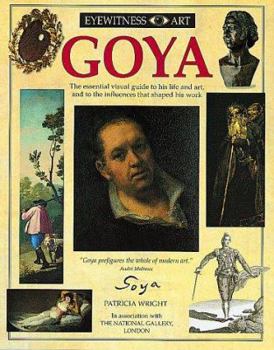Book Overview
This paperback edition of the award-winning study of the life and work of Goya is filled with the same fine reproductions as the original 1994 hardcover. Goya was one of Spain's greatest and most... This description may be from another edition of this product.
Format:Hardcover
Language:English
ISBN:1564583333
ISBN13:9781564583338
Release Date:January 1993
Publisher:DK Publishing (Dorling Kindersley)
Length:64 Pages
Weight:0.05 lbs.
Dimensions:0.5" x 8.8" x 11.2"
Age Range:9 to 12 years
Grade Range:Grades 4 to 7
Customer Reviews
2 ratings
A thought-provoking book... but come to your own conclusions
Published by Thriftbooks.com User , 20 years ago
This was my introduction to Goya. The great thing about this book (and about all the books in Phaidon's Art & Ideas Series) is that it does an excellent job of putting the artist in historical context. I think this is important, because Goya (like David in France) really is inseparable from his time, and we simply can't understand his images if we don't have any idea about what was going on in Spain and the rest of Europe at the time. "The Disasters of War", for example, means so much more to me now that I understand what happened when Napoleon invaded Spain. I was also glad to see that pictures by some of Goya's contemporaries are included, pictures that would otherwise be pretty hard to find. Some of the author's interpretations, though, annoyed me. Intellegent readers shouldn't have any problems drawing their own conclusions, but I'm a little more concerned about readers who aren't very good about questioning authors. For example, when talking about "The Second of May 1808" and "The Third of May 1808", Symmons says that the figure stabbing the horse in the first painting is the same man lying dead in the heap of bodies in the second one -- and then she says that repetition of figures like this is a major theme in Goya's works. It is, but apart from the fact that both of these men are wearing green coats, there's no way of saying they are the same man. Maybe Goya said they were, but if he did, the author hasn't pointed that out. Another quirk is the author's search for Goya's sources. I understand that artists borrow motifs from each other every now and then, but when Symmons tries to tie in a couple of Goya's images with political prints by James Gilray, for example, simply because some of Goya's poses (which really aren't that unusual) vaguely resemble some of Gilray's, I think she's going out on an awfully big limb. Maybe Goya did take them from Gilray, but he could have taken them from a thousand other places just as easily, and without more substantial proof of Goya's sources, I just don't see what the author is trying to accomplish. This is a very useful book, but leave room for forming your own opinion about Goya.
A very nice monograph on Goya.
Published by Thriftbooks.com User , 24 years ago
Janis Tomlinson, the writer of this book, seems primarily concerned in showing that there is a continuity in Goya's work, that it did not suddenly change from light-hearted to dark after Goya went deaf. For the most part, I feel she achieved this end, I for one am convinced. I wish she wrote more on Goya's technique and his personal life, both of which she does not go into much. The 300 or so colour reproductions of Goya's work are excellent, and there are many good close-ups. Unfortunately, Goya produced around 1,800 works, so it is disappointing that only a fraction of them are in this book.





